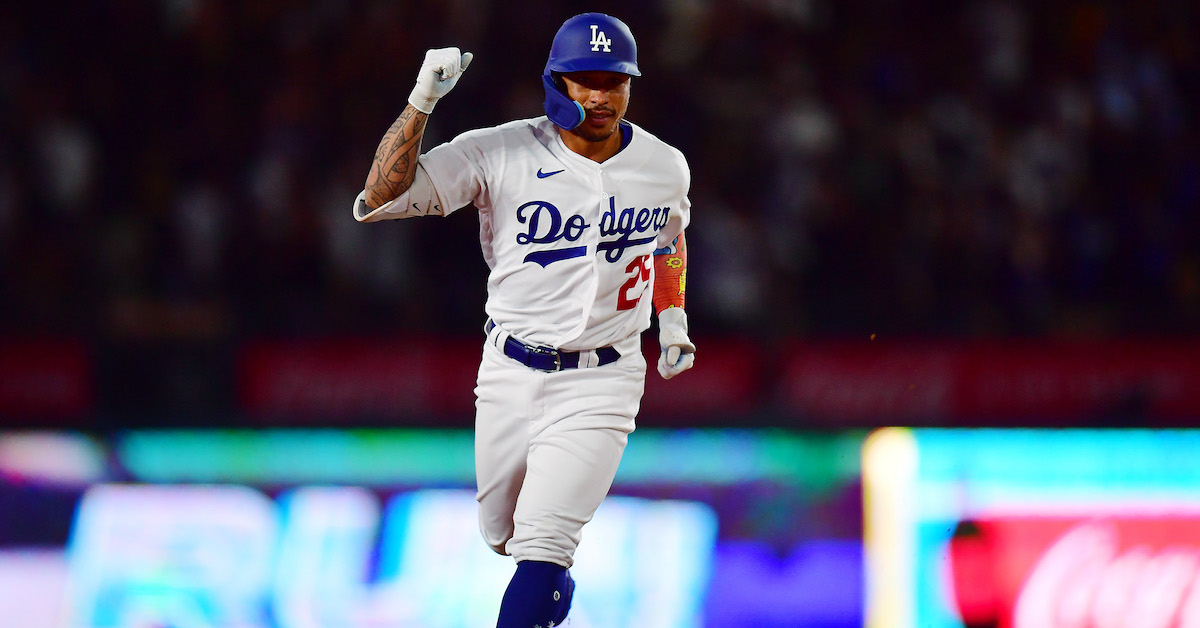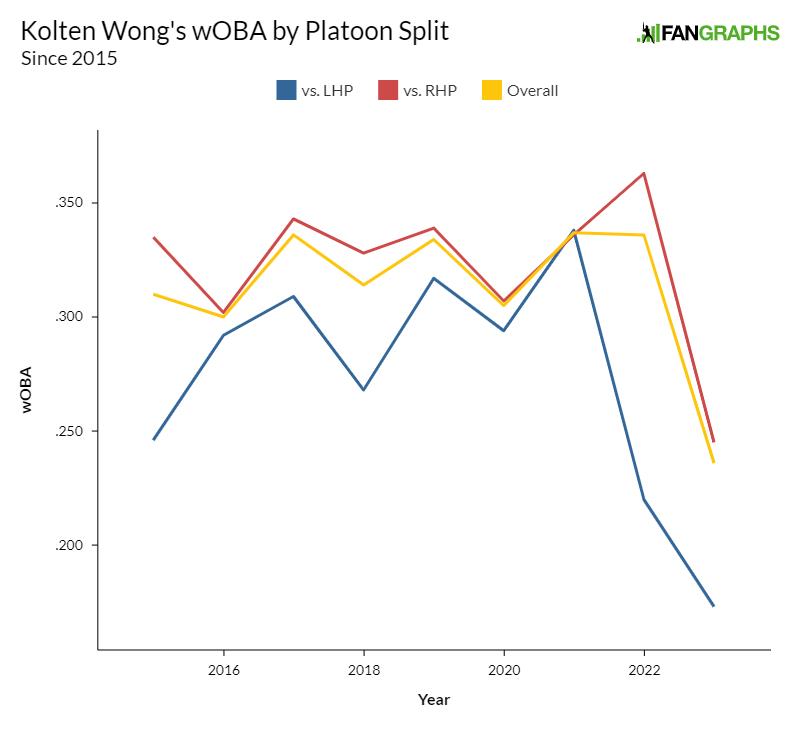
Gary A. Vasquez-USA TODAY Sports
On Wednesday, the Baltimore Orioles signed two veterans — pitcher Julio Teheran and second baseman Kolten Wong — to minor league contracts with non-roster spring training invites. The Teheran signing has a pretty obvious logic: The veteran right-hander hasn’t been anything like a frontline starter in the majors since about 2016, or even a reliable rotation option since 2019.
But despite having come up with the Braves around the same time as Lew Burdette, Teheran is still only 33. He threw 71 2/3 competent innings for the Brewers last year, with only a 17.4% strikeout rate but a 4.40 ERA, which will play for a guy on a tryout. After the Corbin Burnes trade, the Orioles — who wanted badly for starting pitching in 2023 — had assembled a formidable front four of Burnes, Kyle Bradish, Grayson Rodriguez, and John Means. But Bradish and Means both suffered health setbacks that’ll at the very least delay their ramp-up for the season.
In short: The Orioles just had two rotation spots open up suddenly and Teheran was available, presumably cheap, and capable of sucking up major league innings. It’s a bit harder to see the need for Wong, who last year had a wRC+ of just 48 and was nearly a win below replacement in just 250 plate appearances.
More to the point, the Orioles need another infielder like they need a poke in the eye.
Even after sending Joey Ortiz to Milwaukee in the Burnes trade, the Orioles have more infielders than they can use. So let’s get dialectical about this and go through every situation to make the pieces fit, like I did two weeks ago with the Reds and their similar glut of talented young infielders.
Right now, the RosterResource depth chart has the Orioles’ starting infield as Jackson Holliday at second, Gunnar Henderson at short, and Jordan Westburg at third. And assuming Holliday doesn’t fall on his face in spring training, that’s probably how I’d have the O’s line up if I only cared about winning from the jump.
Henderson was a top-10 MVP vote-getter and the AL Rookie of the Year last year. Let’s consider him as the Orioles’ co-best player, along with Burnes and Adley Rutschman. Last year, Henderson split his time almost exactly evenly between third base and shortstop, but for now let’s just say he’s going to play every competitive inning he can this season, somewhere on the left side of the infield.
Henderson is one of three franchise players the Orioles have at up-the-middle positions, along with Rutschman, and presumably Holliday. I count as many as 17 other position players in the Orioles system whom I’d feel comfortable starting somewhere in the infield or outfield, at least in certain situations. But none of them are much better than a league-average starter at their positions. In some cases, it’s age (coming or going), or athleticism, or platoon considerations.
And if you want to get on my case about Austin Hays or Anthony Santander actually being a first-division starter, that’s fine. Because either way, the Orioles probably won’t be able to punt their surplus infielders over to first base and DH the way the Reds can. Baltimore already has more first basemen and designated hitters than it can use.
So the Orioles have eight players for two starting positions and either two or three major league bench spots: Wong, Holliday, Westburg, Ramón Urías, Jorge Mateo, Nick Maton, Connor Norby, and Coby Mayo.
Westburg is going to make the roster. He just turned 25, he’s a recent first-round pick, and last season he got 228 plate appearances and hit .260/.311/.404 as a rookie. Westburg split time between third base and second base last year, but isn’t an exceptional defender at either, which leaves room for a backup to come in as a defensive replacement. He could be a platoon candidate; against lefties he posted a 121 wRC+ in the majors, compared to just 84 against same-handed pitching. But that’s not much of a sample to go on. If you factor in his minor league numbers, Westburg put up a reverse split across all levels, hitting 20 points better and slugging more than 160 points better against righties than lefties.
The Orioles could pick their spots with Westburg, or just run him out at third base every day and let him sink or swim.
After that, it comes down to roster construction. The Orioles currently have 39 players on their 40-man roster spot, with Félix Bautista and his busted UCL already on the 60-day IL. Holliday might be ready soon. Norby is almost 24, and is coming up on 700 career plate appearances at Triple-A. If he’s not ready now, he’ll never be. Mayo is a little further away, but could debut this year.
None of them are on the 40-man roster. Neither is Wong, as it stands. That’s an obstacle to any of them starting the season on the major league roster, though not an insurmountable one. As spring training goes on, players across the league will get hurt, there will be waiver churn, and I wouldn’t be surprised if the Orioles make at least one trade to beef up positions of weakness from positions of depth.
But anyone not currently on the 40-man would have to dislodge someone. Holliday is the most obvious breakthrough candidate, but the Orioles could still decide to slow-roll him and promote him later in the season. Regardless, Holliday’s fate is in his own hands. Wong is not in competition with the no. 1 prospect in all of baseball.
No, he’s in competition with Mateo, Urías, and Maton.
Can he do it? Well, let’s not mince words. Wong was horrendous last year. A brief renaissance in which he hit .300/.353/.500 after moving from the Mariners to the Dodgers should be taken with a grain of salt, as Wong only batted 34 times in a Dodger uniform. From 2022 to 2023, all of Wong’s markers went down. He made less contact, made less hard contact, struck out more, swung at pitches out of the zone more, swung and missed more, walked less. His defensive metrics, once among the best in the league at second base, went in the toilet. Wong got the full Space Jam treatment.
Which is kind of wild, because in 2022 he was pretty good, especially against right-handed pitching. At this point, Wong is probably a platoon bat only. That’s fine, because as a left-handed hitter, it’d be the long side of the platoon.

And in 2022, Wong showed weakness against offspeed and breaking stuff, but he hit .313 and slugged .520 against fastballs, with a whiff rate of just 13.6%. Maybe there’s not a full-time starter in there, but there’s a useful bench player.
The guys he’s up against aren’t unbeatable. Both of the incumbent backup infielders, Urías and Mateo, are right-handed, which works in Wong’s favor.
But they’re not scrubs either. Urías can actually hit pretty well; his career wRC+ is 107. Mateo, on the other hand, has spent his whole career waiting for someone to solve the riddle of “What if you could steal first?” But he’s coming off back-to-back 30-steal seasons and — unlike Wong and Urías — actually played shortstop last year.
Let’s say the Orioles think Wong is a better fit for their roster than one of the incumbents. If Baltimore wanted a left-handed hitting backup infielder who can’t play shortstop, who hit under .200 last year but killed fastballs and righties in 2022, they already have Maton. Baltimore purchased Maton from Detroit three weeks ago; I don’t know if the cash involved in that transaction is enough to give Maton any kind of incumbency advantage, but it can’t hurt his chances, either.
Maton hit .173/.288/.305 in his only season with the Tigers, which is a 67 wRC+, and explains why Detroit was willing to let him go on the cheap. But unlike Wong, who’s spent a grand total of one inning in the past seven seasons at any defensive position other than second, Maton has played second, third, and limited shortstop. He also moonlighted as a corner outfielder with the Phillies in 2022. In limited action that year, he hit .406 against fastballs.
If all four of the veterans in Baltimore’s backup infielder competition work out, I’d probably rather have Maton than Wong, given his youth and positional flexibility. But the reason to bring Wong in is that at this end of the roster, nobody is a sure thing. And if there is a glut at the position come the end of March, Baltimore will have a surplus to trade from— especially as Urías, Mateo, and Maton are all out of options.
Most likely, this is not as big a signing as it looks. Because Wong is a relatively big name, it isn’t immediately obvious that this is a tryout. The Orioles could use another body to stand near second base while their Triple-A pitchers walk guys in the later innings of spring training games. Wong needs a chance to rediscover his swing and rebuild his value before the regular season starts. If he plays his way into a job, great. If not, hopefully one of the 29 other teams will take a shot on him in four weeks.
Source
https://blogs.fangraphs.com/what-could-the-orioles-want-from-kolten-wong/
 Backyard GrillingWeekend WarriorsAdvice from DadBeard GroomingTV Shows for Guys4x4 Off-Road CarsMens FashionSports NewsAncient Archeology World NewsPrivacy PolicyTerms And Conditions
Backyard GrillingWeekend WarriorsAdvice from DadBeard GroomingTV Shows for Guys4x4 Off-Road CarsMens FashionSports NewsAncient Archeology World NewsPrivacy PolicyTerms And Conditions
